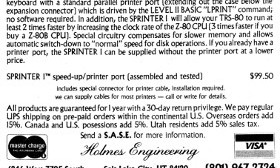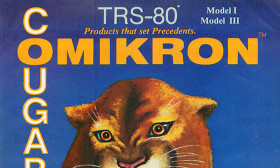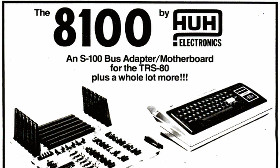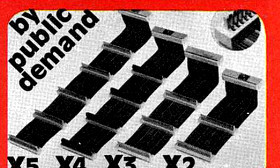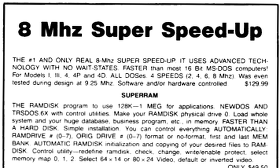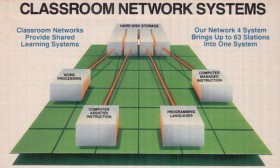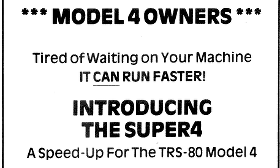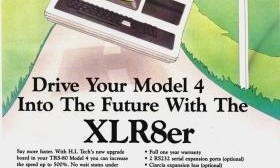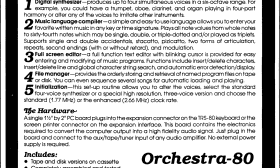Articles in the "Hardware" Category
The Holmes Sprinter was a family of speed-up boards for the TRS-80 Model I and III. They were created and sold by Holmes Engineering, Inc., a company responsible for many hardware add-ons for the TRS-80, such as the Expansion Mainframe, the VID-80, and the Internal Memory. The Sprinter models were probably the most popular speed-up boards available for the Model I and III.
The Sprinter I for the TRS-80 Model I was introduced in late 1981. It cost $99.50, which was more expensive than its primary competitor, the Archbold Speedup Board. However, the Sprinter I had one big advantage over the Archbold Speedup Board: it could be installed with no soldering at all. Installation required just a few steps:
(Read more...)
The Omikron Mapper was the first (and probably most popular) CP/M hardware add-on for the TRS-80 Model I and Model III. It allowed unmodified CP/M programs to run on a TRS-80, something not normally possible. The Omikron Mapper was introduced in 1979 by Omikron Systems, a Berkeley, California company run by George Gardner.
Omikron Systems sold three versions of the Omikron Mapper from 1979 to 1984:
- The original Omikron Mapper I was for the Model I. In 1979, it cost $169.00 for a version that could use 5 1/4" floppy drives. A version that could use 8" drives cost $199.00.
- The Omikron Mapper II was a data separator that allowed a Model I with Expansion Interface to run CP/M using a combination of 5 1/4" and 8" drives. In 1980, it cost $99.00. Omikron originally bundled the Mapper I as part of the Mapper II, but later sold them separately. In addition to CP/M, NEWDOS/80 could also use the Mapper II to access 8" drives.
- The Omikron Mapper III was for the TRS-80 Model III. Unlike the Mapper I, it only supported 5 1/4" drives. It cost $199.00 in 1983.
(Read more...)
After the Radio Shack TRS-80 Model I was introduced in 1977, many companies were said to be developing an interface to allow the Model I to use the wide selection of S-100 hardware available at the time. HUH Electronics of San Mateo, California was one of the few companies (if not the only) to actually release a S-100 interface. Their Model 8100, introduced in November 1978, had six slots to allow up to six S-100 devices to be connected to the Model I.
The S-100 bus standard was created by MITS in 1975 for their Altair 8800 computer. The Altair 8800 was designed with one mainboard with five 100-pin edge connectors. These connectors were used to attach the CPU, memory, and other peripherals to the Altair. These connectors followed a standard that became known as the “Altair bus.” Many people started creating and selling hardware designed to plug into the Altair bus. Competing computers, such as the IMSAI 8800, also used the standard, but under the name “S-100 bus.”
(Read more...)
The TRS-80 Model I, unlike some other contemporary computers, offered no way to install expansion cards internally. The Model I did have an expansion bus connector which allowed users to attach external hardware devices, such as the Radio Shack Expansion Interface. But the single connector meant that only one hardware device could be attached to a Model I at a time.
The Expandabus from Alpha Products, introduced in 1981, provided a way for TRS-80 Model I owners to connect multiple devices to the expansion bus, allowing up to five devices to be connected to a single Model I.
The Expandabus was similar to the T-Buss, which was one of the first TRS-80 items Alpha Products sold. The T-Buss cost $80.00 and allowed five devices to be connected to the Model I. The Expandabus was more flexible and available in four versions:
- the X2-40 for $29.00, which could connect two devices.
- the X3-40 for $44.00, which could connect three devices.
- the X4-40 for $59.00, which could connect four devices.
- the X5-40 for $74.00, which could connect five devices.
(Read more...)
The Seatronics Super Speed-Up was the fastest commercially available speed-up board for the TRS-80 Model 4. It could double the Model 4 speed to 8 MHz, without requiring any performance sapping memory wait states. The Super Speed-Up was sold by Seatronics, a company based in Maastricht, Holland, for $129.00. (A review in 80 Micro identified Sylvester Technologies of Cypress, Texas as the United States distributor, but that appears to have been a mistake.)
The Super Speed-Up was also available for the TRS-80 Model I and Model III, but the Model 4 version was the most common.
Installation of the Seatronics Super Speed-Up was more involved than other Model 4 speed-up boards. The first step of the installation was simple, consisting of removing the Z80 and plugging the Super Speed-Up board in its place. But subsequent steps involved cutting pins, moving wires, straightening a pin, running a wire, and possibly soldering a resistor. David Dalager in Computer News 80 described the installation as “not for the average computer user.”
(Read more...)
The Network 4 was a classroom networking system sold by Radio Shack that was popular in computer labs in the mid-1980’s. It allowed one computer used by a teacher to be connected to up to 63 student computers. The Network 4 was based around the TRS-80 Model 4, well after MS-DOS computers became more common. It was probably one of the biggest reasons the TRS-80 Model 4D remained in the Radio Shack catalog until 1990.
In the early days of microcomputers, schools were viewed as a major market for computers. The Radio Shack Education Division, formed in 1980, aggressively promoted the use of computers in schools. In 1985, they stated that “Radio Shack is the leading marketer of microcomputers to schools, with more TRS-80 computers in America’s schools than any other brand.”
Radio Shack had been pushing the idea of connecting computers in schools since 1980 under the name “TRS‑80 Network”:
(Read more...)
The Super4 was a popular speed-up board for the TRS-80 Model 4. Introduced in 1984 by Alpha Technology, Inc. (not to be confused with Alpha Products), the Super4 was both inexpensive and easy to install. As the advertisements stated, it required “No trace cutting. No soldering. No wires to connect.”
The Super4 package contained everything necessary for the speed-up, including a faster Z80 chip. Installation consisted of unplugging the 4 MHz Z80 CPU from the Model 4 and plugging the Super4 into the now empty Z80 socket.
(Read more...)
The XLR8er (pronounced accelerator) was a speed-up and memory expansion board for the TRS-80 Model 4, regarded by many to be the ultimate Model 4 expansion. The XLR8er replaced the Model 4 Z80 CPU with an enhanced microprocessor that offered 256K of additional memory (for a total of 384K) and up to double the speed. The XLR8er originally sold for $299.95 (with memory) when H.I. Tech, Inc. introduced it around 1986, but that price soon dropped to $249.95.
The XLR8er hardware was based on the SB-180 single-board computer project that was presented by Steve Ciarcia in the September and October issues of BYTE and sold by MicroMint. The XLR8er was close enough to the SB-180 design that it was able to accept “Ciarcia” expansion modules designed for the SB-180.
(Read more...)
The MegaMem, introduced in early 1990 by Anitek Software Products, was the ultimate memory upgrade solution for the TRS-80 Model III and 4. By using the same high capacity SIP (single in-line package) memory modules used in PC compatibles at the time, the MegaMem allowed a Model 4 to be upgraded as high as 8MB. Unlike the HyperMem, an earlier Anitek memory upgrade product, the MegaMem required no soldering, trace cutting, or other surgery to the computer. Peter Ray, the president of Anitek, described the MegaMem as the upgrade for “people who can spend extra money and hate soldering.”
(Read more...)
Like many personal computers at the time, the TRS-80 Model I had fairly primitive built-in sound capabilities. That changed in 1980 with the introduction of the Orchestra-80, a small $79.95 unit that plugged into the TRS-80 and could play music with four simultaneous voices over a six octave range. Orchestra-80 was sold by Software Affair, Ltd., a company created by Bryan Eggers and Jon Bokelman. It became one of the best remembered hardware add-ons for the TRS-80.
Orchestra-80 had predecessors in two earlier kit products for S-100 computers. In 1977, Software Technology Corporation introduced the STC Music System, which featured “Musical Arrangements by Jon Bokelman.” In 1979, after the STC Music System was no longer available, California Software Co. introduced the Software Music Synthesis System. Also created by Jon Bokelman, the Software Music Synthesis System, or SMS, maintained the same syntax as the STC Music System, even though it was a completely different product.
(Read more...)
